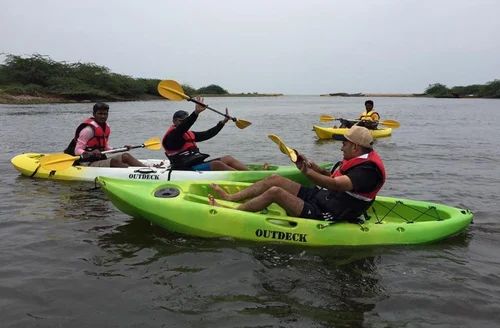Introduction
Kayaking and canoeing are thrilling water sports that offer a unique opportunity to explore the great outdoors, navigate serene lakes, and conquer roaring rivers. Whether you’re looking for a peaceful way to commune with nature or an adrenaline-packed adventure, there’s a kayak or canoe trip for you. To make the most of your aquatic escapades, having the right gear is essential. This guide will walk you through the must-have equipment and gadgets for kayaking and canoeing.
Paddles
Paddles are your primary means of propulsion on the water, so it’s crucial to choose the right ones. The design and material of the paddle can greatly affect your paddling experience. Here are some considerations:
Material: Paddles are typically made from materials like aluminum, fiberglass, and carbon fiber. Aluminum paddles are durable but heavy, while fiberglass and carbon fiber paddles are lighter and more efficient.
Blade Shape: Paddle blades come in various shapes, including dihedral, asymmetrical, and symmetrical. Each shape offers different performance characteristics. For instance, dihedral blades reduce flutter and are ideal for touring.
Shaft Design: The shaft can be straight or bent. Bent shafts offer a more ergonomic grip, reducing strain on your wrists during long paddling sessions.
Length: The length of your paddle should be appropriate for your height and the type of paddling you’ll be doing. Longer paddles provide more power, while shorter paddles are easier to control.
Life Jackets (PFDs)
A personal flotation device (PFD) is a non-negotiable safety item when kayaking or canoeing. These are designed to keep you afloat in case you capsize or get into trouble. When choosing a PFD, consider the following:
Type: PFDs come in several types, including Type I, II, III, and V. Type III is the most common for paddlers, as it offers a balance of buoyancy and freedom of movement.
Fit: Your PFD should fit snugly but not restrict your movements. Look for adjustable straps to ensure a secure fit.
Pockets: Some PFDs come with pockets for storing small essentials like a whistle, knife, or sunscreen. These can be very handy.
Buoyancy: Check the buoyancy rating to ensure it’s appropriate for your weight and the conditions you’ll be paddling in.
Kayak and Canoe
Of course, you’ll need a kayak or a canoe to get on the water. The choice between the two depends on your personal preferences and the type of water you’ll be navigating.
Kayak: Kayaks are small, narrow watercraft designed for one or two people. They are great for solo adventures or kayaking with a friend. Kayaks are versatile and come in various styles, including sit-in and sit-on-top, each with its own set of advantages.
Canoe: Canoes are open boats that can accommodate more passengers and gear. They are perfect for family trips or for those who prefer a more relaxed paddling experience. Canoes are stable and allow for easy access to your gear.
Safety Gear
Safety should always be a top priority when paddling. In addition to PFDs, there are several other safety items you should consider:
Helmet: If you’re planning on white-water kayaking, a helmet is essential to protect your head in case of collisions with rocks or other obstacles.
Bilge Pump: This handy device helps you remove water from your kayak or canoe, especially if you capsize.
Spray Skirt: If you’re kayaking in rough water, a spray skirt can keep water out of your kayak and help you stay dry.
Throw Bag: A throw bag contains a length of rope that can be thrown to a person in the water in case of an emergency. It’s a vital piece of rescue equipment.
Navigation Tools
To stay on course and navigate effectively, you’ll need the right tools:
Maps and Charts: Waterproof maps and charts are essential for planning your route and staying aware of your surroundings.
GPS Device: A waterproof GPS device can provide accurate location data and help you track your progress.
Compass: A reliable compass is a backup navigation tool in case your GPS fails.
Waterproof Phone Case: Keep your phone protected in a waterproof case to access GPS apps and emergency contact information.
Gadgets and Accessories
In addition to the basics, there are several gadgets and accessories that can enhance your paddling experience:
Dry Bags: These waterproof bags keep your gear dry and are essential for storing items like extra clothing, food, and electronics.
Paddle Leashes: Paddle leashes secure your paddle to your kayak or canoe, preventing it from floating away if you capsize.
GoPro: Capture your water adventures with a waterproof action camera like a GoPro to relive the excitement later.
Deck Bags: Deck bags attach to your kayak or canoe and provide convenient storage for items you want to access quickly, like snacks and a camera.
Conclusion
Whether you’re a seasoned paddler or just starting, having the right gear is essential for a successful kayaking or canoeing adventure. From the basics like paddles and PFDs to safety gear, navigation tools, and fun gadgets, the right equipment can make a world of difference. Remember, safety should always be your top priority, so never compromise on essential items like PFDs and helmets. With the right gear in hand, you’re ready to paddle your way to unforgettable waterborne experiences.


